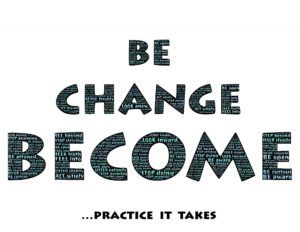Culture Change: Senior Leaders Must Lead The Way
Culture Change: 30 Years of Lessons Learned
It’s been a long time coming, 11 years and multiple drafts, but I’m excited to announce that my book is finally looking like it is going to be completed. Yay! In my book, I share the many things I’ve learned over 30+ years of searching for the answer to one question: How do we achieve meaningful and sustained culture change in organizations?
This is one of the chapters from the book. I am offering it in the hope it provides some useful insights but also to ask for your feedback. I would sincerely appreciate any thoughts or suggestions you would care to share. Thank you in advance! Onwards….
Lesson 1: Senior Leaders Must Lead The Way
Who is accountable for an organization’s culture? The answer is leaders. By ‘leaders’, I mean anyone at any level who others look to for guidance, especially people who hold senior positions in an organization. The reason is simple — leaders are the single most important factor in determining the success of any culture change effort.
If you rolled your eyes and said ‘duh…everyone knows that’, you’re not alone. After all, if senior leaders are committed to the change effort, they will make it a priority and allocate the resources, required to be successful. Right? The answer is ‘yes and…’
Absolutely, leaders must commit time, people and money if the change effort has any chance of being successful. The thing is they need to go further which means owning it. They must be fully committed to the change and personally involved in a meaningful way in all phases of the change effort. Sure, they are going to need help, but they are going to have to lead the way which means showing — not just telling — others what is expected, making tough decisions and creating the conditions for success. It can’t be a, nice to do, nor can it be delegated to Human Resources or others.
Isn’t Culture a Human Resources Thing?
In almost every organization I’ve worked with, Human Resources are responsible for culture. Leaders might say they own it, but the reality is they typically articulate values and, in some cases, identify the culture the organization needs, communicate this to employees and then hand off the heavy lifting to Human Resources to make the change happen. Unfortunately, this doesn’t work.
Don’t get me wrong. Human Resources plays a critical role in culture change. They own a lot of the processes that encourage and reinforce expected behavior, such as hiring practices, performance management systems, advancement criteria and so on. Leadership and organization development professionals can also provide leaders with expert guidance and support in areas such as behavior change, coaching and feedback and change management. In other words, Human Resources can and should be strategic partners helping leaders with the change effort, but they cannot do it for them.
Why not? Three reasons —- behaviors, practices and environment.
Leaders’ Actions Send Messages to Others
Leaders Reinforce Culture in Day-To-Day Practices
Leaders Create the Conditions for Success (Environment)
Bill's Story
Bill had recently been hired to replace the outgoing CFO who was retiring. He brought to the role 25 years of experience and a proven track record leading several finance organizations in the telecommunications industry. The company he joined was a relatively young organization but growing quickly as it capitalized on new and emerging technology. It was known to be innovative and entrepreneurial with tremendous growth potential.
It wasn’t long before Bill realized that this entrepreneurial spirit included what he described as ‘an allergic reaction to anything resembling discipline, structure or process’. Employees, led by senior leaders, saw these as bureaucratic impeding their ability to be flexible, responsive and take risks; qualities that had played a major part in their success to date. As a result, past efforts made by the Finance team to introduce more discipline in areas such as budgeting, reporting and analysis never got off the ground. Bill experienced this first hand at one of the early meetings he attended with the rest of the executive team.
The executive team was meeting to decide on the coming year’s advertising plan and budget. Several options were on the table for consideration requiring a sizable financial investment. The discussion was animated as executives shared their opinions as to the best way to proceed. This went on for a while with a lot of back and forth as people discussed the merits of the different options. When Bill suggested they consider the results from past advertising campaigns, there was silence. It turns out, there was no data available. Marketing didn’t have any performance metrics and wasn’t tracking results. Executives were making decisions involving millions of expense dollars based on intuition and personal preferences.
The more questions he asked and investigating he did, the more he realized this was the way things were done. Discipline was simply not part of the culture. He saw examples everywhere he looked from day-to-day practices such as meetings and appointments to decisions involving millions of dollars. While the entrepreneurial spirit was great, the lack of discipline was costing the company large sums of money due to rework, redundancies, poor decisions and so on and so forth. This was also contributing to productivity and performance issues, as well as taking people away from doing higher value work. The challenge, as he saw it, was to introduce more discipline without crushing innovation and agility.
The Solution Part 1 – Behaviors and Practices
Recognizing the difficulties in attempting to tackle the issue at the enterprise level, he decided to focus on things within his immediate control and sphere of influence. He started by introducing practices designed to bring more discipline into the way the Finance team worked starting with meetings and appointments. Bill reinforced these practices with his own behavior. For example, he made it clear that people were expected to be on time and prepared when attending meetings, no exceptions and no excuses. To this end, he introduced the following practices and behaviors:
Appointments and One-on-One Meetings
Practices
- To schedule an appointment with Bill, people had to explain why the meeting was required and the expected outcome. If his input or a decision was required, relevant background information was to be provided so he could review it prior to the meeting.
- Appointment times were strictly adhered to. If someone was more than 5 minutes late, the appointment was automatically cancelled, and the person was forced to reschedule another date. This was a big deal as it was extremely difficult getting time with him. It could be weeks before the next opening in his schedule. People quickly learned to be on time.
- Bill’s schedule included time for travel to meetings, unexpected requests, preparation and other events. While there were times when emergencies required a change to his schedule, these were the exception and time was blocked to allow for canceled appointments to be rescheduled at an early date.
Behaviors
- Bill was always on time for appointments and he expected the same of others.He read everything provided in advance. If the work provided wasn’t up to his standards, he would send it back and, in some cases, canceled the appointment. Initially, he provided clear written feedback as to what was missing and questions that needed to be answered. This happened once. After that, the person was expected to figure out what was missing and fix it.
- At the end of one-on-one meetings, he provided feedback including what was done well and needed to be improved for the next time. For example, he expected people to provide a recommendation with their rationale when asking him for input or a decision. His feedback included coaching to help the person improve the quality of their recommendations.
Meetings
Practices
- Meetings started and ended exactly at the scheduled time. If the meeting was to start at 9:00 a.m., he locked the door and started the meeting. People were not allowed to enter the meeting after it started. This included his boss and other senior people. It caused quite a stir at the beginning!
- Bill introduced a set of practices aimed at improving the efficiency and effectiveness of meetings. These included publishing the meeting agenda with background information to be reviewed one week ahead of the meeting date. The agenda included the ‘ask’ for each item, such as provide input, identify issues or obstacles, make a decision or provide information. Items that fell into the ‘provide information’ category were reviewed to determine if these could be effectively addressed in other ways and removed from the agenda. The amount of time allowed for each agenda item was determined by the complexity of the topic and the “ask”. In the meeting, these timelines were strictly adhered to albeit with some growing pains at the outset. Initially, agenda items were closed without having achieved the “ask”. As the team got better at using the available time, this became the exception rather than the rule.
- He also implemented meeting principles that clearly defined expectations for behavior. These included being present and engaged which meant turning off cell phones and other non-essential devices. To address potential emergencies, he provided a person outside the meeting to contact. These principles were posted on the meeting room wall and used as a form of performance review at the end of each meeting. Specifically, the team quickly did a ‘green, yellow, red’ scorecard of each principle to indicate what they did well and needed to do better. A brief discussion of the ‘do better’ principles clarified expected changes for the next meeting.
Behaviors
- Bill always arrived at least 5 minutes early for every meeting. If it was someone else’s meeting, he would wait 10 minutes and if the meeting hadn’t started, he would leave. Initially, this was a problem with his boss and his peers, however, he was able to manage the issue by getting their buy-in and agreeing to return to meetings if required. He made his point swiftly and effectively.
- In the first meeting he hosted, one person made the mistake of not taking him seriously and answered a call. Bill stopped the discussion, walked up to the person and held out his hand for the phone. He told the person at the other end to call back when the meeting was over and turned off the phone. He then took the phone and dropped it in the garbage can. Everyone laughed, and the discussion continued. At the break, the phone’s owner approached Bill and apologized asking if he could have his phone back. Bill said no. The rules were clear and there needed to be consequences. If he wanted a phone, he was going to have to get a new one. The story traveled through the building like wildfire.
Within days, people began to show up on time for their appointments with Bill. Within a few weeks, people consistently arrived on time for meetings and not just his meetings but also meetings hosted by his boss and others in the organization. Meetings became more efficient and effective and people appreciated that they could depend on the fact that meetings would always end on time.
This discipline wasn’t restricted to appointments and meetings. He applied the same principles to performance management, written communications, business case preparation, presentations and an assortment of other practices. He used every opportunity to bring greater discipline into day-to-day work and interactions.
Four months after Bill joined the company, employees described a significant, observable culture shift towards increased discipline resulting from the behaviors and practices he role modeled. Although initially limited to the Corporate Finance team, they were already seeing evidence of change elsewhere as other leaders and teams followed his lead.
The Solution Part 2 - Creating the Conditions for Sustained Success
An Interim Solution – Paving the Way for Change
Prior to Bill taking over as CFO, the vast majority of Finance professionals were generalists who reported directly to business unit leaders. Their responsibilities were broad and included budgeting, cost and sales estimates, expense management, reporting and anything else the business unit leader needed. A few specialists reported directly to the CFO handling Corporate level fiduciary requirements, such as Treasury, Investor Relations, Financial Planning and Analysis (FP&A), and Controller/Accounting.
The Finance generalists concentrated their efforts on meeting the needs of the business unit leaders. As a result, every business did things differently. They had their own way of estimating sales and revenue, budgeting, reporting, managing costs, analyzing results and so on. When it came time to pull together financial information at the enterprise level, the Corporate team had a mess on their hands, if they could get the information they needed from the business at all. This led to long delays and inaccurate and incomplete financial information that no one trusted.
Many of the processes required to solve this problem were already in place. The issue was they were not being followed. One option was to mandate that the businesses comply with the Corporate processes, however, this would put the Finance generalists in the difficult position of having to push back on leaders and not deliver what they wanted. This wasn’t realistic given business leaders set the Finance generalists’ objectives, assessed their performance, determined rewards including merit increases, and had a significant say in advancement and development opportunities. Asking the generalists to put Corporate needs ahead of the business and go against the wishes of the business leader was setting them up to fail.
In the short-term, Bill decided to do things that didn’t totally resolve the situation but certainly improved it. The first was to insist on a greater role in setting expectations and evaluating the performance of the Finance generalists. By making this a shared responsibility, he was able to align their objectives with his priorities while at the same time providing an incentive to consider Corporate Finance requirements when they set priorities. Second, he sought agreement from business leaders to comply with the processes most critical to addressing the issues with the timeliness and accuracy of financial information. Given the severity and visibility of the problem, it was relatively easy to get the support he needed. With this in place, he quickly deployed resources to ensure expectations were clear, and the processes and tools understood.
Phase Two – Process Changes
With the immediate problem addressed, Bill directed his attention at making the changes required to achieve his goal of increasing the discipline applied to cost management and decision-making. To this end, he identified and set about implementing a set of initiatives targeted at improving the timeliness, quality and quantity of financial information available to business managers when making decisions. This included launching a major Activity Based Costing (ABC) initiative, adding rigor to the approval process for new hires and capital funding, and spearheading a new business priority and objective setting process. He also partnered with the CIO to lead the implementation of a decision-support system (data and analytics). These initiatives were prioritized and carefully planned so as not to disrupt business-as-usual while ensuring progress was made as quickly as possible.
Recognizing this was not a strength in Finance, or elsewhere, Bill established and staffed a new Project Management Office (PMO). The PMO was responsible for helping the various project teams effectively plan, implement, monitor and report on their progress. Although not entirely successful, due to new hires who clashed with the existing culture, it resulted in a level of consistency and transparency that had been absent from past initiatives.
Phase Three – Structural Changes
Approximately six months after the business leaders agreed to follow the prioritized Finance processes, there continued to be major issues with the timeliness and accuracy of financial information. Despite their assurances, the business leaders had quickly reverted to their old ways of doing things insisting that the Finance generalists make their needs a priority. While most of the generalists did their best to deliver the information required by Corporate, workload pressures and competing demands meant delays and inaccurate and incomplete information was the norm.
The situation came to a head when the company was called to task by outside analysts for overestimating projected revenue and failing to notify the market that expectations were going to be missed. Although painful, this was the opening Bill needed to restructure the Finance function. He immediately moved to change reporting relationships so the generalists reported directly to him and indirectly to the business leaders.
Making this happen was not easy. The business unit leaders fought hard to maintain the status quo. They argued that the current structure allowed them to focus their Finance staff on business priorities, such as pricing, competitive bids and so on. They feared that a centralized structure meant they would lose control of these resources which would cause delays in getting the Financial support required to effectively manage their P&L. In the end, the financial forecasting and reporting issues outweighed their concerns and the CEO supported Bill’s restructuring plan.
Almost overnight, things started to improve. The Finance generalists still had a difficult task as saying no to business leaders is never easy. Knowing their boss, Bill, supported them and would step in to help when needed went a long way to giving them the confidence and courage they needed. Indeed, in the early days, there were several stories of Bill confronting business leaders and C-suite executives who tested the new way of doing things. This only had to happen a few times for the situation to improve but the message was clear. This was the new world order…take it or leave it.
Of course, sustainability ultimately depended on Finance’s ability to deliver timely, accurate financial information that addressed the company’s fiduciary obligations and a need for greater discipline in cost management and decision-making. If the problems persisted after the change, things would have quickly reverted back to the old way of doing things. Fortunately, the changes resulted in an immediate improvement to the quality and accuracy of financial information and only got better as the more complex, longer-term initiatives were implemented.
Two years after he was hired, Bill had achieved his goal of increasing discipline in cost management and decision-making. He also changed the culture. By changing core processes and structures, he created the conditions to encourage and sustain higher levels of discipline not just in Finance but across the company. However, as the business unit leaders had feared, there was also a decrease in the flexibility and responsiveness that was such a valued part of the company’s entrepreneurial culture. This contributed to a level of resentment and disapproval of the changes Bill had introduced, although most leaders acknowledged that it was the right thing to do. This rebalancing or calibration of culture attributes is part of the challenge of changing culture, and a topic for a later chapter.
In Summary
















